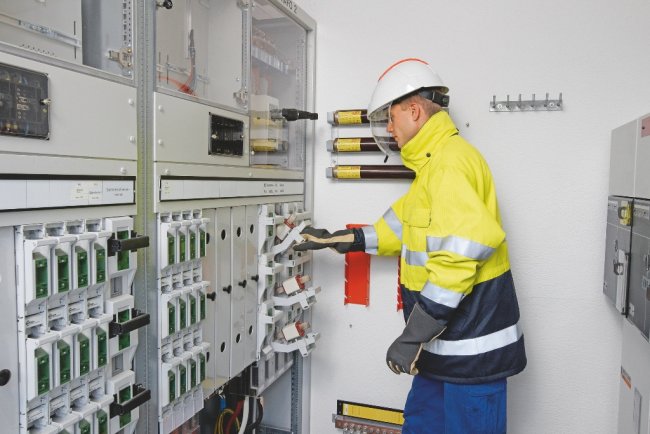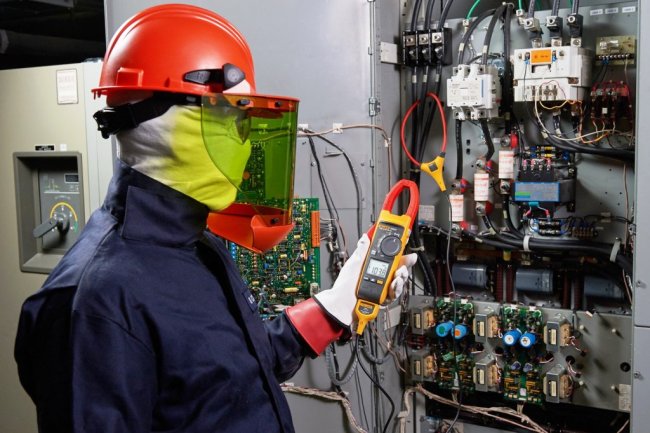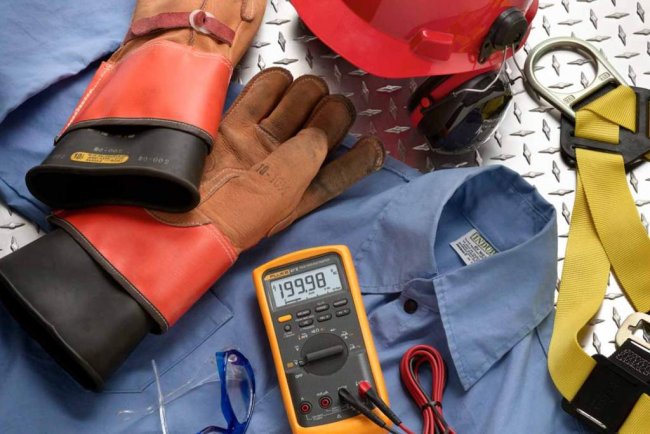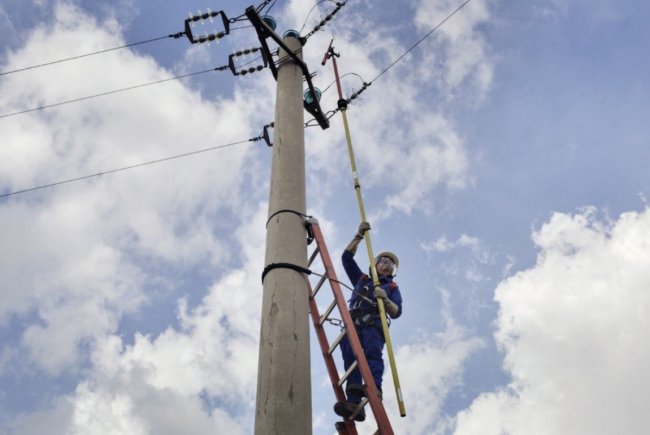Improving the effectiveness of means of protection against electric shock in electrical installations
Means of protection against electric shock, as well as means of protection against the impact of other dangerous and harmful factors, are divided into collective and individual, and protective devices are also inclined to personal protective equipment.
The difference between personal protective equipment and devices is that the former have only protective functions, while the latter have both protective and technological functions. For example, dielectric gloves are a protective device and insulating pliers are a tool.
Portable earthing switches, as well as grounding blades in devices such as disconnectors, are used exclusively for protective purposes. Therefore, both should be referred to the group «earthing devices for live parts».
Along the way, we note that it is wrong to equate the terms "protective equipment" and "personal protective equipment".
To further clarify the scope of means of protection against electric shock (up to electric arc), it is advisable to divide them into means that prevent people from touching electrically dangerous elements, and means that provide protection against such touches, and those — of the nature of the hazardous elements.
In view of the above, the classification of electric shock protection equipment is shown in the table below.
Protective equipment against electric shock
Means to prevent touching live parts
Touch protection
for live parts to non-conductive parts of live and dead parts
Collectively
Insulating coverings Earthing devices for live parts Protective earthing devices, earthing Residual current devices (RCD) Shells Potential equalization devices Isolating transformers Fencing Arrests Low voltage sources Locking devices Voltage limiters Locks Lightning arresters Signaling devices Safety signs, placards Movement restrictors
Individual
Overlays Carpets Gloves Caps Stands Helmets Boots, galoshes Fixing belts Cabins Safety ropes Playgrounds Bars Stairs Mites Telescopic lifts Tension indicators Bench and installation tool
Note: In the name of personal protective equipment and devices (except helmets, cabs and harnesses), the words "dielectric" or "insulation" are omitted, and after "ticks" the word "measurement".
Mobile and portable protective equipment and devices used when working in electrical installations when they are carried out without de-energizing, in turn, are differentiated into basic and additional (according to their ability to ensure human safety at a certain voltage).
None of the known means guarantees complete safety and therefore in practice several means are used for the same purpose, for example protective earthing devices and residual current devices, interlocks and safety signs.
More than 80% of the cases of industrial electrical injuries occur when touching live parts (directly or through various metal "objects" — car cranes, excavators, trucks, communication lines, pipes, installation tools, etc.).
In both industrial and non-industrial electrical trauma, the proportion of injuries due to the transition of voltage to the body of an electrical installation is approximately the same.
In the workplace, injuries due to single-phase contact with live parts of installations above 1 kV occur almost as often as when touching parts with a voltage of up to 1 kV.
With double-pole contact, most injuries occur at the transformer substation and switchgear, with single-pole contact - on overhead lines, and with body contact - on mobile and portable equipment. That is why, first of all, it is necessary to increase the effectiveness of the means of collective and individual protection used when working on these installations.
Using injury statistics alone, it is impossible to determine how many lives are saved due to the use of safety equipment—this requires information on the likelihood of injury in the absence of equipment, if any.
For example, to calculate how many incidents are prevented in 1 year thanks to the use of residual current devices (RCD), you need to know the probability of touching all workers during the year to parts known to be live, as well as to parts of equipment that are energized as a result of an accident and the probability of electric shock as a result of such contact in the presence and in the absence of RCD.
On average, one in four cases of electrical injury is related to the lack, unreliability or non-use of protective equipment. As expected, most injuries were due to the non-use of non-automatic safety equipment (PPE, tools and devices, safety signs).
Exact matching of electrical injury data related to insulation failure and protective earthing devices and grounding — an accident. One in three injuries caused by insulation failure is caused by touching live parts, not equipment frames.
Currently, the most effective means of protection against dangerous contact with live parts are projectiles, permanent fences and insulating coatings, and in case of contact with the body, protective grounding and neutralization.
Inefficiency of protective earthing and earthing in production is associated with 25% of accidents.
The most common violations of the rules for the installation and operation of grounding devices include the use of twisted pieces of wire as grounding wires, connecting several energy consumers in series to one grounding device, and not grounding individual units of equipment consisting of several units.
Dangerous grounding defects are not connecting the grounding wire to the zero of the power source, installing fuses, switches and bells in the neutral wire, including neutral wires per phase, using equipment boxes, cable armor, water pipes as a working neutral wire.
When zeroing is used, it is necessary to control not only the resistance of the neutralizing wires, but also the impedance of the phase-zero loop. Failure to understand the importance of this measure is one of the reasons why grounding has been discredited as a measure of protection against electric shock.
Normally, the break in the neutral wire occurs suddenly. Therefore, the control of the reset circuit must be automatic. Most accidents due to violation of the rules for the installation and operation of protective grounding and grounding devices occur during the operation of mobile and portable power receivers.
Practice shows that it is impossible to eliminate these shortcomings only through organizational measures. Protective grounding (earthing) of equipment and devices must be duplicated or replaced by other technical measures. These are double isolation and safe shutdown.
When grounding is used, it is recommended to replace fuses with automatic switches installed on all three phases, use automatic control circuits for the grounding circuit, check the resistance of the phase-neutral loop in a timely manner, re-ground the neutral wire in close proximity to the protected object using natural grounding devices.
In many enterprises, the condition of grounding devices is checked by specialized organizations. It is important that the workers of these enterprises are provided with diagrams of the earthing devices that must be checked.
Residual current devices (RCDs) essentially duplicate protective earthing or neutralization. Unfortunately, due to the low level of insulation of some electrical networks, the RCDs installed in them must be turned off — otherwise equipment downtime cannot be avoided. It is necessary to exclude the disconnection of the RCD by increasing the quality of the insulation of the electrical networks and the selectivity of the RCD, since most electrical injuries occur when the protective devices are disconnected.
Interlocks and signaling devices serve to prevent wrong actions by personnel that may lead to incidents or accidents, as well as to prevent people and mechanisms, in particular mobile cranes, from approaching live parts at an inadmissibly close distance.
In electrical installations, interlocks are mainly used where there are circuits with a voltage higher than 1 kV — in distribution devices, transformer substations, high-frequency electrothermal installations, on test stands, etc.
Wrong can be not only accidental actions of the staff, but also intentional. Incidents are mainly due to failure of mechanical interlocks.
Dielectric gloves wear out quickly, break in the cold. Elastic latex gloves may be recommended. The polymer materials from which the insulating coatings of the mounting tool are made also do not have sufficient mechanical strength.
Many enterprises do not have the opportunity to check gloves, galoshes and other protective equipment, which is why the deadlines and volumes of testing of the specified means and devices are not observed.
See also:Dielectric Protective Equipment: Testing of Dielectric Gloves, Overshoes and Boots, and:Conditions for testing electrical protective equipment




